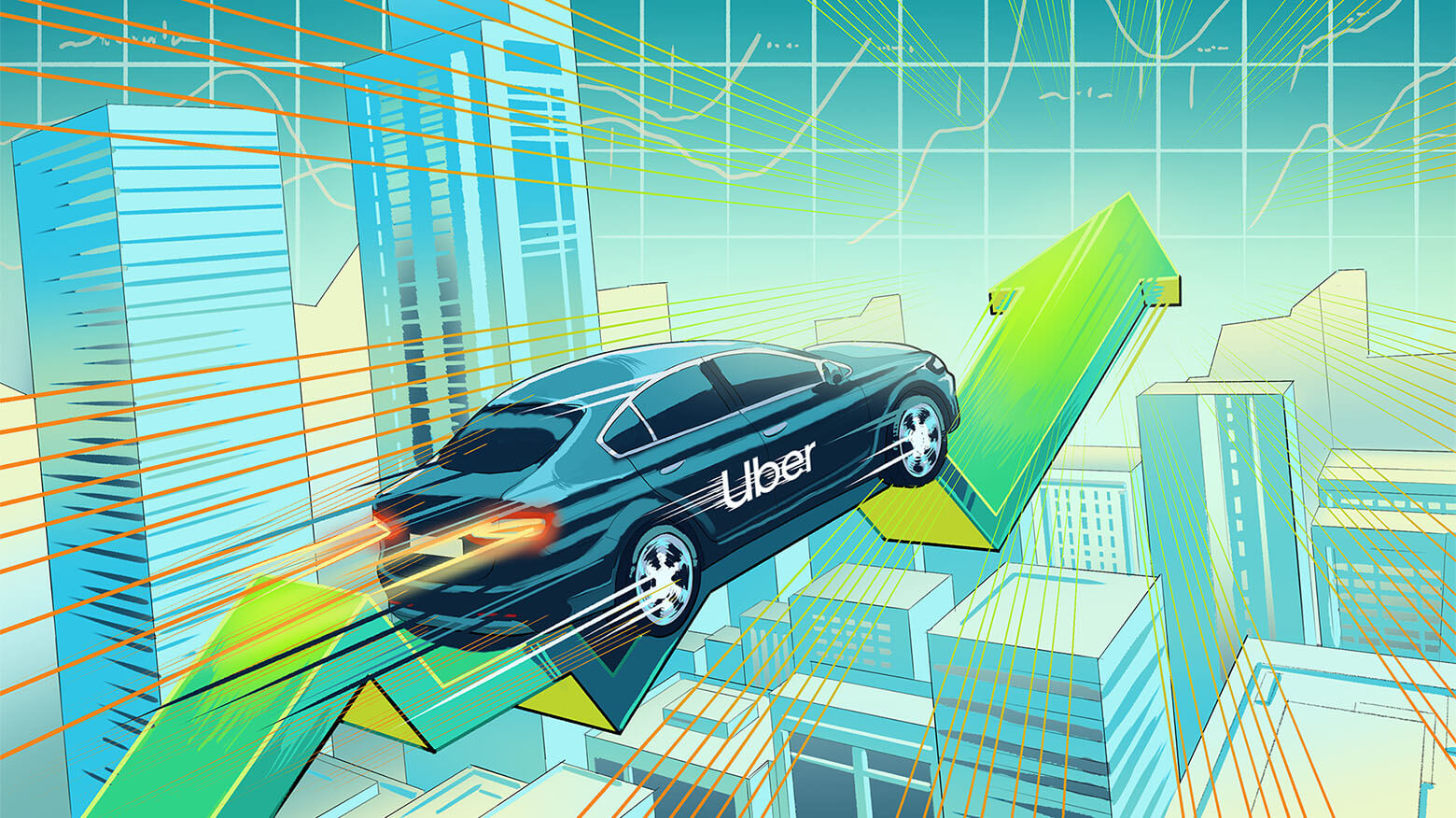October 2021
I talked about why we – value investors – decided to buy Uber stock back in January 2020, a month before the pandemic really got rolling. We were buying Uber stock throughout the pandemic, even in the very dark hours of March 2020. We still own it today and were buying it as recently as August.
A lot of things have changed since January 2020, but overall our thesis is still intact and has even gotten better. Uber Eats will likely turn into a viable, profitable business. Uber is expanding into adjacent delivery markets for groceries, alcohol, and packages. Advertising will become a meaningful business for Uber (it has almost a 100% margin). Uber took the pandemic as opportunity and rationalized its cost structure, cutting a quarter of its workforce. Uber announced that it has turned EBITDA-profitable in recent months. I know, it seems like a low bar for a company of this size, but it is a first step to reaching escape velocity to significant profitability as revenues continue to grow.
Below is my original analysis. It’s long, but worth revisiting today.
January 2020
This had never happened before. Several clients reached out to us wondering if I had been kidnapped and someone else was making investment decisions in their accounts. The gist of their questions was, how you can go from making conservative investments to buying a dotcom-like stock that is losing money? How can this company even be a value investment?
I was happy to get these questions, for two reasons. First, it’s clear clients are paying attention to what is going on in their accounts. I really want IMA clients to know what they own and, most importantly, why the own it. This is why I write long quarterly letters to them about their investments. And second, the questions have allowed me to measure the temperature of people’s opinions about the company in question.
What and Who
Let me introduce you to our What, Who, and How Much framework.
Imagine you are in 1998; this new internet thing is complete chaos; it’s the Wild West. Wild West because there are a lot of possibly very profitable and certainly disruptive business models emerging. Chaos because it’s incredibly difficult to see which business models and which companies are going to succeed. So in 1998 you don’t know what and don’t know who.
Fast-forward to … 2003. At this point we can clearly see that advertising and classifieds dollars will shift online. We know what will happen. But we still don’t really know who – the market is very fragmented and no obvious leader has emerged. Yahoo!, Ask, Bing, AltaVista, MySpace, and Google are still duking it out for market share.
Fast-forward again to 2010. At this point no one has any doubt that digital advertising is the future and analog (or paper, to be more accurate) is a relic of the past. Any ambiguity is removed from what, and the who is Google (and Facebook, but I’ll ignore Facebook here for the sake of simplicity). Google has become a verb; the company dominates search – its biggest competitor at this point is Bing, which has a tiny, shrinking 2.5% market share. People are Googling, not Binging.
Google’s scale gives it an enormous competitive advantage: The more data it has from past searches, the better results it can provide for future searches. Google made some brilliant decisions along the way. Instead of fighting Apple in its own domain, it gave away the Android operating system to hardware manufacturers. Today Android powers half of the mobile phones sold in developed countries and 80% of phones globally.
The problem is that, with the exception of a very few moments in 2010, Google has looked statistically expensive on the basis of current or next-year’ earnings. However, if you looked five or ten years out, you’d have realized that digital advertising would be taking market share from analog and thus would double and then quadruple. Since Google was the who (its dominance was likely to grow), it would capture the bulk of the profit from growth of the search engine advertising market. If you looked at Google’s earnings power through a spyglass instead of a microscope, it was insanely cheap and significantly undervalued, though it would not show up on a single value screen.
Here is what we learned from this: When we see a tsunami of disruptive change (the what), we need to identify the who.
A lot of times it is easier to identify the what than the who. For instance, we spent a lot of time looking at the legalization of online sports betting in the US – it is clear to us that this industry will explode. But we could not identify the who – a company that today we can clearly see will be able to capture a meaningful chunk of the profits in five or ten years. A few years down the road it will be easier for us to see which companies will dominate that space, but we will have paid a price for this insight, because the who will have appreciated a lot by then. At the same time, there will be a lot of companies that looked like reasonable contenders but vanished from the map. So identifying the who is not always easy.
Finally, how do you figure out how much? This is where it gets really difficult, because you can’t build models analyzing these companies with any kind of precision; you need to put your sharp pencil away and take out a crayon. Here is where the first three of our Six Commandments of Value Investing come to the rescue. First, margin of safety: Make sure you buy cheap enough that if the future is not as bright as you anticipate, you don’t lose money. Which brings us to the second commandment: The true risk is not volatility – temporary gyrations – but permanent loss of capital – a stock declining and not coming back. And finally, have a long-term time horizon. When you look at the who in the industry, ask yourself, five years out, what is my most conservative, most uncreative estimate of value? These types of companies have a good chunk of their value not in today’s but in future earnings. Using conservative estimates of revenue and earnings growth and giving them a conservative valuation multiple five years out, you can arrive at a worst-case valuation. If your current price is not much different from this number, you have a margin of safety.
This brings us to the what: what’s the industry that we foresee to have explosive future over the next few years?
That’s a long discussion. So long that I’ve broken it up into a 4-part email series. If you want to read the whole thing, you can sign up using the form below:










Greetings Mr. Katsenelson,
The investment analysis of Uber was very good, imo. But it is a bit outdated versus the current environment in April of 2024. Robotaxies have made a lot of progress and there is already a commercial robotaxi service in Las Vegas. Waymo is looking to expand to something like 14 more cities in the next year or two. Tesla is also pushing hard on FSD and robotaxies. And there is a lot of progress on robotaxies in China.
Consequently I think it is critical to revisit the potential robotaxi impacts on Uber. Various pundits are predicting robotaxies will have very low per mile cost (.25/mile, for instance). We are starting to see announcements from CATL of batteries that will last 1 million miles, and a number of supposed experts (Tony Seba, et al) think EVs will last 1 million miles, which is probably 5X the lifespan of an ICE based car. There are lots of other important cost data points (insurance, parking, yada yada). Bottom line I think EV robotaxies in 3 years will indeed be way way cheaper than the cost of a private automobile.
If so, this will supposedly drive a material reduction in personal car ownership which may end up being 50%+ lower eventually. So we may end up with a market dynamic where car companies end up in a rapidly shrinking market with the main opportunity for retaining market share coming from robotaxies. Competition could be fierce in that environment among car makers.
If so, then the ability to scale rapidly (whoever gets biggest the fastest wins) might drive robotaxi manufacturers to partner with Uber rather than compete heads up. If so, Uber would see very fast growth as the total ride share market expands as people choose ride sharing over buying and operating private cars.
Alternatively, it may turn out that replicating enough of Uber’s software infrastructure to enable robotaxi services turns out to not be that difficult, and robotaxi companies that choose to compete heads up with Uber will not have the challenges of firing millions of drivers. Vertical integration may provide much better margins. Tesla appears to be headed that direction.
The above is just an attempt to poke at some of the more obvious potential impacts. But I am hoping it drives home the point that robotaxies will have a huge, and perhaps existential, impact on car companies and possibly Uber. Getting a handle on the various future robotaxi scenarios and their probabilities seem crucial to your Uber investment thesis going forward.
Most investors I talk to feel that robotaxies are 10 years away and not worth worrying about in regards to Uber’s future. I disagree. My sense is we will start to see the rollout of robotaxies in 2-3 years in geofenced areas in large cities and associated urban areas (already plans for that for SF and peninsula and LA).
It also seems important to assess what impact robotaxies will have on Uber’s network and platform moat.
It would be very useful, and perhaps essential, to Uber stock owners to get an up-to-date analysis of robotaxies, their potential timing, and potential impacts on Uber. I am hoping you may be inclined to provide such an analysis! I believe it would attract a lot of interest.
Anyway, this was a great article and very worth reading.
Best regards, Tim Sharick